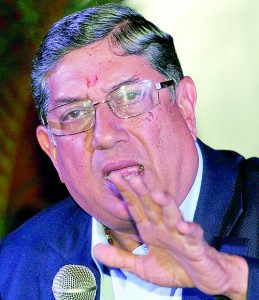Living under the Indian tree: The droplets and the bombshell
View(s):Living under a huge tree has its advantages and distinct disadvantages. Living under a tree so big will keep you away from the scorching sun, giving you ample shade to stay cool. Yet, when it rains you tend to get bathed twice — once in the rain and then from the droplets off the leaves. Finally, in the fall you stand there right underneath, bare to the bone, daubed by the fallen leaves.
You certainly don’t look a pretty sight at all.
 For Sri Lanka from the foreword of its history, this has been the case. Living right under the nose of India has provided it with a tray full of treasures which need no explanation. Beginning from the very civilisation that has created you and me, the tear drop of the Indian Ocean has derived its rich legacy by being where it stands. At the same time it also has had to wade off its wrath on many an occasion through the gallery of its history.
For Sri Lanka from the foreword of its history, this has been the case. Living right under the nose of India has provided it with a tray full of treasures which need no explanation. Beginning from the very civilisation that has created you and me, the tear drop of the Indian Ocean has derived its rich legacy by being where it stands. At the same time it also has had to wade off its wrath on many an occasion through the gallery of its history.
However in this exchange of ideas, we may confine ourselves to something that began quite alien to both India and Sri Lanka. But, through a few niggles in their combined history, they became part and parcel and are better disciples now than the inventor himself. Yes, I agree we are talking about the game of cricket.
Though both countries have a cricket history dating back more than one hundred years, the sun shone on the big tree in 1926 when the then Imperial Cricket Conference (consisting of England, Australia and South Africa) opened its wings to accommodate, New Zealand, the West Indies and India. The West Indies played their first Test in 1928, New Zealand in 1929-30 and India in 1932. Pakistan was the next to climb the platform in 1952. Yet, living under the tree made us insignificant bystanders.
The first whiff of real cricketing life came our way in 1964 on a plea made by Pakistan to the cricket masters to broadbase the game. That year, Sri Lanka (then Ceylon), Fiji and the United States were taken into the fold as the first Associate members. From that point onwards the Lankans gave up its cricket perambulation and began the home run till it reached the desired goal in 1981.

If the Mudgal commission finds N. Srinivasan guilty, there is a strong possibility that the tide may turn against the man who has occupied the three most important positions in the Indian Cricket Administration -- treasurer, secretary and president -- since 2005.
Today, three decades later, both Sri Lanka and India are Asian cricketing giants. But, the burden of living under the tree has escalated than ever before.
Undoubtedly India is the richest cricketing nation on planet Earth.
With its billion plus cricket crazy public, the game became an iconic pastime thus pumping in millions upon millions of valued dollars to the cricket coffers. At the same time, the International Cricket Council — quite aware of the Indian impact in cricket — awarded the hosting of the World Cup to the country on three occasions. The first time India went on its own. The second time a few hosting scraps fell off the giant tree towards Sri Lanka, but the lads who were still new to the cricketing world surprised the rest by taking home the trophy in 1996.
Then on the third occasion when the World Cup bid came to the Indian sub-continent in 2011, the lads under the shade of the huge tree were sizable partners. Likewise the Lankans lived up to the expectations and rode on to the final to take on the giants living up the three. Yes, India won and Sri Lanka lost, but, literally the real losses came in a different manner. Instead of refurbishing the land at hand, the Lankans went in for new stadia in a politically mingled move. The rupee losses made by the midget host became too huge a burden. With the coffers empty, like seeking the shade of the big tree the Lankan dependency on India became almost the lifeline. If the Lankans get a series against India, they get their stipend to survive with million dollar TV income. So the Lankans have to live with the “three bags full” policy with India for survival. Jumping the rail means the daggers are drawn.
Spurred by the IPL success in India, Sri Lanka Cricket (SLC) in a bid to redeem itself financially launched the Sri Lanka Premier League. The move did not go well with the giant. They scuttled it and the Lankans slid into a bigger financial rut than before. There was a time when Indian cricketers almost made Sri Lanka their second home and the Lankan coffers were stable. But, when Lanka tried to break free, screws began to tighten and an Indian cricket trip to Lanka became scarce as ice in Sahara.
Then when the India-led ‘big three move’ came to light, the Lankans clearly knowing the repercussions tried to come out of the shadows along with Pakistan and South Africa. Yet, whom did Sri Lanka hurt? India. Badly pummeled, the Lankans had to go on bended knees and plea for clemency and in turn received a few scraps so that they could live on.At the same time, there is turmoil in the Indian cricket administration. The 2013 IPL match fixing scandal has rocked it and has decapitated it. The ‘Big Three’ mover N. Srinivasan is now living under the microscope. India has opened its Pandora’s scoreboard in cricket.
To add to the beleaguered BCCI’s woes the change in the central government also may not be the best news for those who have their hands daubed in mud.
Arun Jaitley, a former president of the Delhi and District Cricket Association but still a political player in the BCCI, is appointed finance and defence minister in the new government. His new job has left him little time for BCCI matters, but he knows more than a few secrets of what transpires within those hallowed halls of the Indian Cricket administration.
Then if the Mudgal commission finds N. Srinivasan guilty, there is a strong possibility that the tide may turn against the man who has occupied the three most important positions in the Indian Cricket Administration — treasurer, secretary and president — since 2005. Then there may be more investigations going deep into the roots of corruption. This is where the falling of the leaves on the big tree becomes important. Out of the shadows of the tree would there be rays of light falling upon people who are living under the tree?
Now in New Zealand, scandals what transpired during the infamous ICL are coming to light.
Taking the above into consideration, could there be any fingers pointed towards the little guy who is living under the tree, because the leaves are sure to fall on someone in the near future.


